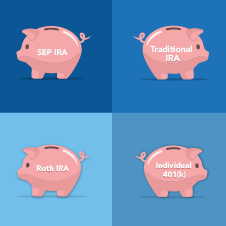Outside the Box: Alternative Retirement Savings Options
by Commonwealth Financial Network
 As of March 2018, only 51 percent of working Americans in the private sector had access to a defined contribution retirement plan (i.e., a 401(k) plan), according to the Bureau of Labor Statistics. In establishments with fewer than 100 employees, that number was just 46 percent. That’s a large percentage of the population without access to traditional retirement savings options. With studies suggesting that Americans currently have a savings deficit and today’s employees less likely to stay with one company for their entire career, it’s imperative as an advisor to ensure that clients have a backup plan so they continue to save on a regular basis. To start, you need to understand your clients’ individual situations, and your clients need to be aware of alternative methods to save for retirement.
As of March 2018, only 51 percent of working Americans in the private sector had access to a defined contribution retirement plan (i.e., a 401(k) plan), according to the Bureau of Labor Statistics. In establishments with fewer than 100 employees, that number was just 46 percent. That’s a large percentage of the population without access to traditional retirement savings options. With studies suggesting that Americans currently have a savings deficit and today’s employees less likely to stay with one company for their entire career, it’s imperative as an advisor to ensure that clients have a backup plan so they continue to save on a regular basis. To start, you need to understand your clients’ individual situations, and your clients need to be aware of alternative methods to save for retirement.
The three most typical retirement plans include the following:
- Defined contribution plan: The two most common plans are a 401(k) and a profit-sharing plan. If employee salary deferrals, employer contributions, or forfeitures were made to your client’s account within the current tax year, your client would be considered covered by a workplace retirement plan.
- IRA-based plan: This would be either a SEP or SIMPLE IRA plan. If your client contributed to an IRA-based plan within the current tax year, he or she would be considered covered.
- Defined benefit plan: With this pension plan, if your client receives a benefit according to the terms and conditions of the plan within the current tax year, your client would be considered covered.
If you have clients who aren’t covered by any of the above plans, ensure that they seek out an alternative best suited to their needs.
Clients who are currently employed but aren’t covered by a workplace plan can open their own tax-advantaged investment vehicle, including the retirement savings options listed below.
The traditional IRA. As with a 401(k), clients may be able to make tax-deductible contributions to an IRA, provided they are below the modified adjusted gross income (MAGI) thresholds.
- For single individuals, deductibility begins to phase out with MAGI of $64,000 and is eliminated with MAGI above $74,000.
- For married couples filing jointly with one spouse covered by a workplace retirement plan, deductibility begins to phase out with MAGI of $193,000 and is eliminated with MAGI above $203,000.
- For a married couple filing jointly with neither spouse covered by a workplace retirement plan, there is no MAGI threshold.
In summary, clients with income less than the lower income levels can make fully deductible contributions, while clients who fall somewhere in between will receive only a partial deduction. Contributions are still permitted for clients with income over the MAGI thresholds; however, they would be considered after-tax contributions.
Earnings on either contribution type would continue to grow tax deferred over the years, and once your client turns 59½, the money can be distributed penalty free.
The Roth IRA. Unlike a traditional IRA, Roth IRA contributions are made with after-tax money, and clients’ MAGI must be below the thresholds for the client to be eligible to make a contribution. Whether a spouse is covered by a workplace retirement plan is not a factor—the client’s MAGI will determine eligibility. Income must not exceed $137,000 for single individuals (phaseout begins at $122,000) and $203,000 for married couples filing jointly (phaseout begins at $193,000).
Although your clients won’t receive a tax break on their contributions, there are many benefits of the Roth IRA, including tax-free growth, no required minimum distributions, and penalty-free distributions of the basis at any time. On the other hand, the contribution limit is dramatically lower than that of a 401(k). In 2019, the limit is $6,000 ($7,000 for those age 50 and older) in a traditional or Roth IRA versus $19,000 ($24,000 for those age 50 and older) in a 401(k).
Health savings account (HSA). An HSA is not a typical retirement savings vehicle, but its distribution rules make it worth considering. To start, contributions made to HSAs have a triple tax-saving advantage: They are tax deductible, grow tax deferred, and distributions taken before age 65 for qualified medical expenses are tax free. After age 65, clients can withdraw funds for any reason without paying a 20 percent penalty from the IRS, but they will have to pay taxes on the amount withdrawn.
If a client wants to use an HSA to save for retirement, he or she must be covered by an eligible high-deductible health plan. Contribution limits for 2019 are $6,850 for a family account and $3,450 for an individual account with a $1,000 catch-up provision for those 55 or older. Your clients may want to confirm with their health care benefit provider to determine if they are eligible to open an HSA.
Clients who are self-employed or independent contractors qualify for several other retirement savings options. If they don’t have any employees, they may want to consider opening their own employer-sponsored retirement plan, such as a SEP IRA or individual 401(k), which allows them to avoid the expense and administrative burden of opening a traditional 401(k).
The SEP IRA. Like a traditional IRA, contributions to a SEP IRA are tax deferred, but annual contribution limits are much higher with a SEP IRA. Clients can contribute up to 25 percent of their salary, or 20 percent of their net self-employment earnings for a maximum of $56,000.
The individual 401(k). Also referred to as the Uni-k or Solo-k, the individual 401(k) is a great alternative to a traditional 401(k) for employers who have no eligible employees other than their spouse. Like a traditional plan, the individual 401(k) offers both employee salary deferrals and employer profit-sharing contributions. Salary deferrals are limited to $19,000, and plan holders can make a profit-sharing contribution of up to $56,000 ($62,000 for clients age 50 and older).
Making the choice. The SEP IRA is the easiest to open and contribute to, as clients can do both as late as the employer’s tax filing deadline (including extensions). If your client has lower-than-expected income for the year, a SEP IRA may not be the best option because it’s capped at a certain percentage of compensation for the year. This plan also doesn’t allow for catch-up contributions.
For an individual 401(k), as long as your client’s income exceeds the $19,000 annual limit, he or she is able to defer the full amount and make a profit-sharing contribution, which is essentially the amount your client would contribute to a SEP IRA.
Clients may not be aware of the variety of retirement savings options available to them, but as their advisor, you can help guide them through the decision-making process. There are always opportunities to save for retirement, regardless of an individual’s employment status—it just comes down to finding the right match.
Do you have many clients who aren’t covered by a traditional workplace retirement plan? How have you ensured that they keep saving for retirement top of mind? Please share your experiences below!
Commonwealth Financial Network is the nation’s largest privately held independent broker/dealer-RIA. This post originally appeared on Commonwealth Independent Advisor, the firm’s corporate blog.
Copyright © Commonwealth Financial Network
















